Acoustic levitation method offers contactless transport and handling
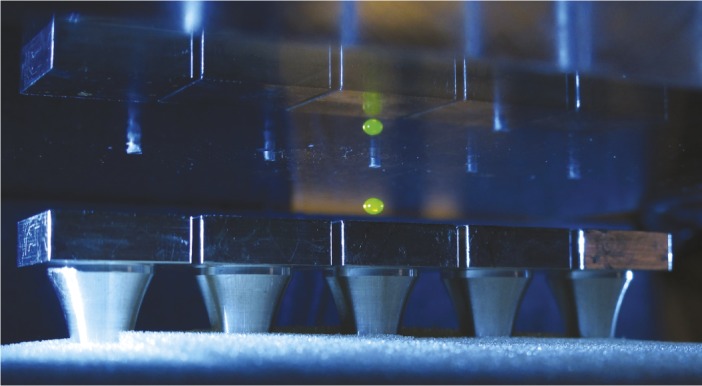
Photochemical liquid switch made by combining acoustically levitated drops.
Levitation, as a contactless technique to move and manipulate matter in air, has numerous potential applications in disciplines ranging from materials processing to biochemistry. State-of-the-art methods, which typically exploit electrostatic, magnetic, or optical principles to generate the force needed to offset gravity, are inherently limited to micrometer-scale particles and/or materials with specialized physical properties. To address these limitations, Daniele Foresti et al. (pp. 12549–12554) present an approach that advances acoustic levitation, offering precisely controlled motion and versatility, and a material independence that removes the need for laborious sample preparation. In acoustic levitation, sound waves between an emitting surface and reflector establish an acoustic field that can cancel out gravity and trap small quantities of matter like tiny liquid droplets in relatively stable, motionless regions known as nodes. The authors’ method modulates the levitating field in both space and time to precisely control and move these nodes, providing a means to simultaneously transport and process multiple objects. The authors also illustrate the techniques’ broad applicability with a range of experiments, including contactless droplet coalescence and mixing, solid–liquid encapsulation, and DNA transfection. — T.J.
Temperature-memory polymers
Temperature-memory polymers enable researchers to dial in the temperature at which the shape change can occur. Usually, this is a one-use feature; stress or deformation freezes in a temporary form, while heat relaxes polymer molecules back to their original state. Marc Behl et al. (pp. 12555–12559) have created a much more versatile kind of temperature-memory polymer that can cycle its shape over 250 times without material fatigue. The wiggly polymer chains are oriented in a skeleton of densely packed polymer crystallites interspersed in the material. The temperature-driven elongation and contraction of domains formed by these oriented polymer chains enable the polymer’s reversible shape changes. The researchers demonstrate potential uses for the material, including temperature sensitive window blinds and a motor that runs on heat. Because the temperature-memory polymer is stable over many cycles, features easily adjusted actuation, and is based on commercially available materials, the authors suggest that their work may spur the development of new products. — J.M.
Hadrosaur tail bears potential evidence of predation by Tyrannosaurus rex
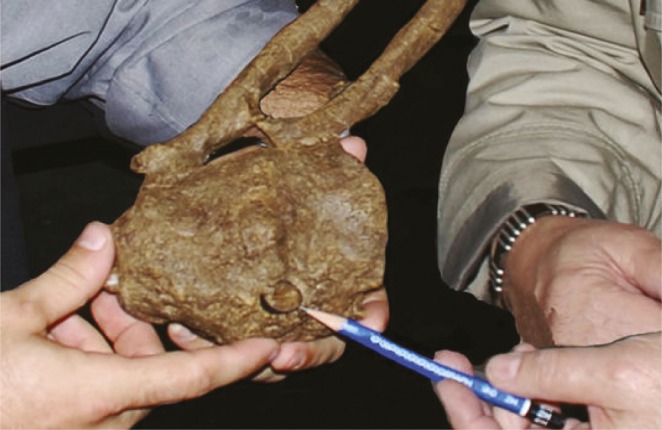
T. rex tooth crown embedded between hadrosaur vertebrae and surrounded by bone overgrowth. Image courtesy of Fallon Cohen (Palm Beach Museum of Natural History).
Lacking definitive physical evidence, paleontologists have long debated whether Tyrannosaurus rex, the carnivorous “tyrant lizard” king of the Late Cretaceous, hunted and killed its prey or scavenged for sustenance. Robert DePalma II et al. (pp. 12560–12564) describe a fossil from the Hell Creek Formation of South Dakota that may help renew interest in the question: a T. rex tooth crown embedded in the spine of a hadrosaur that survived the attack by the carnivore. Previous studies have suggested that partially digested juvenile hadrosaur bones found near T. rex remains were probably the carnivore’s stomach contents, but this evidence doesn’t reveal how the T. rex might have obtained this last meal. The authors report that the tooth crown, lodged between two hadrosaur vertebrae and surrounded by healed bone growth, suggests that the animal escaped and lived for some time after the encounter. Furthermore, the location of the injury, in the animal’s tail, suggests that T. rex may have bitten the hadrosaur while pursuing it. According to the authors, the artifact provides a glimpse into the behavior of a dinosaur that went extinct some 65 million years ago. — T.J.
Ocean acidification can diminish marine ecosystem diversity
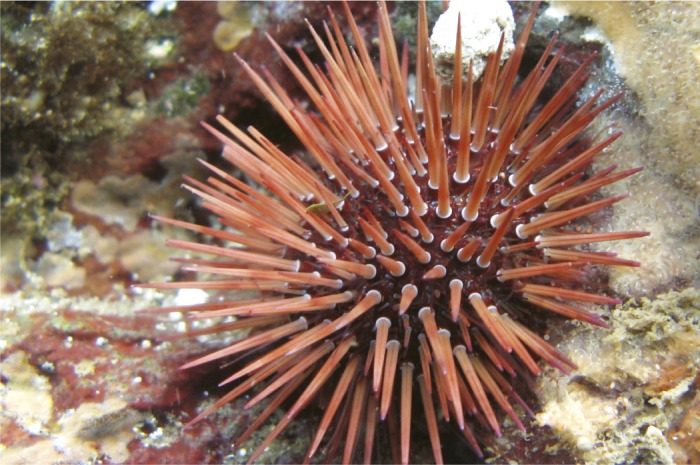
A sea urchin near natural CO2 vents off the coast of Italy.
Disturbances contribute to diversity in ecosystems by removing dominant species and allowing competitively inferior organisms to establish and persist. Researchers anticipate that future climate change will affect the disturbance regimes of many ecosystems, but the community dynamics that govern recovery and perpetuate diversity are not well studied. Kristy Kroeker et al. (pp. 12721–12726) examined disturbance recovery patterns in marine species under different ocean acidification regimes, using an ecosystem that naturally mimics impending scenarios of environmental change. Located off the coast of Italy, the study site contains volcanic vents that release predominantly CO2 at a depth of 2–3 meters, resulting in pH and carbonate gradients. The authors cleared all species from plots of shallow rocky reef near the vents in areas of ambient, low, and extreme low pH corresponding to near-future and extreme scenarios for ocean acidification. Recovery in areas of acidification, the authors report, yielded sharp decreases in community variability and reductions in functional diversity compared with ambient pH conditions. Furthermore, the authors observed increased recovery rates of the dominant taxa species in low pH zones. The findings highlight how near-future environmental change can erode functional diversity in ecosystems by altering community dynamics, according to the authors. — T.J.
Building blood vessels from induced pluripotent stem cells
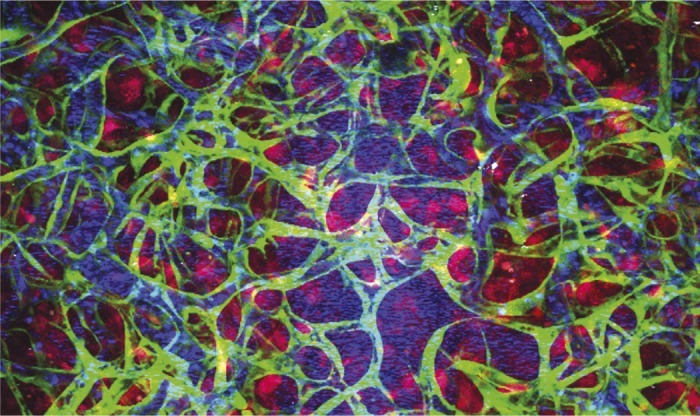
In vivo imaging of hiPS cell-derived blood vessels.
Regenerative medicine holds the possibility that damaged tissues may be repaired in situ, for example, through the implantation of healthy cells capable of generating replacement tissue. More than one-third of Americans experience some form of cardiovascular disease, hence regeneration of blood vessels is of particular interest. Rekha Samuel et al. (pp. 12774–12779) developed a method for growing functional blood vessels in an in vivo model system, starting with human induced pluripotent stem (hiPS) cells. The authors enriched endothelial precursor cells (EPCs) from four hiPS cell lines by flow cytometry, selecting for CD34+ cells that coexpressed certain EPC markers. Endothelial cells derived from these EPCs formed tubes on a substrate of extracellular matrix proteins. When hiPS-derived endothelial cells were suspended in a fibronectin/collagen gel and implanted into a transparent window in the cranium of a SCID mouse, the implanted cells formed stable, long-lasting vessels that formed connections with host vessels and were perfused with blood. The authors also generated a functional vasculature in vivo using hiPS cell lines derived from patients with Type I diabetes. According to the authors, the findings suggest a potential for autologous hiPS cell-based regenerative medicine as an approach for treating vascular disease. — C.B.
Radiation therapy alters neuronal architecture in mice
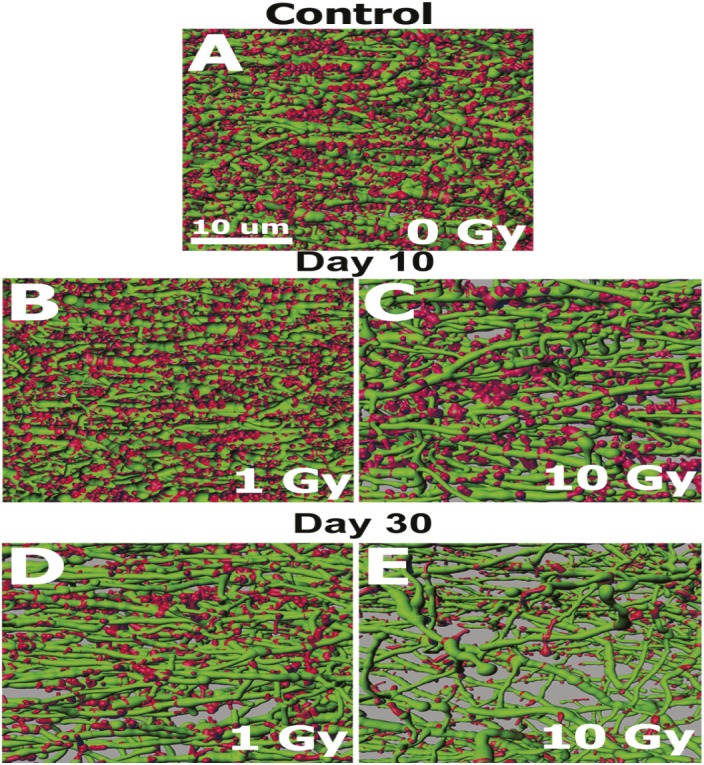
Reduction in dendrite spine density along neurons 10 and 30 days after low (1 Gy) or high (10 Gy) dose gamma irradiation.
Radiation therapy is commonly used to treat brain tumors, but may damage healthy tissue and lead to cognitive impairments. How radiation exposure compromises brain function remains unclear. Vipan Parihar and Charles Limoli (pp. 12822–12827) investigated the effects of radiation exposure on the structure and connectivity of mouse neurons in the hippocampus. The authors exposed mice to two different doses of cranial irradiation, and within 1 month of the treatment, they observed dose-dependent reductions in the branching, length, and area of dendrites—neuronal projections that receive and transmit signals from other neurons. The researchers also found radiation-induced decreases in the number and density of dendritic protrusions known as spines. The radiation-associated changes resemble those found in many neurodegenerative conditions, the authors note. The study reveals that irradiation may have a persistent and adverse effect on the complexity of the neuronal architecture in the hippocampus. Further research is needed to determine the extent that the observed changes contribute to the cognitive impairments experienced by patients who undergo irradiation for the treatment of brain cancer, according to the authors. — N.Z.


